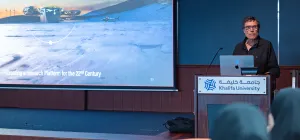Princess Elisabeth Antarctica Research Station Remains Icon of Sustainability

Brussels, May 30 2022 – After 15 years, the Princess Elisabeth Antarctica - the first ever zero emission polar research station - remains the global benchmark in reducing the environmental footprint of conducting polar research and supporting scientists in their research about Earth and its climate system.
As the International Polar Foundation (IPF) celebrates 20 years of service to the public with its friends and partners, IPF will continue to support not only polar research - the station’s primary mission - but also innovative projects seeking more sustainable solutions to do polar research.
Over two austral summer research seasons, from November 2007 to February 2009, the International Polar Foundation, with financial and in-kind help from its many private sector partners and the Belgian government, built the Princess Elisabeth Antarctica station under the Belgian flag. Inaugurated in February 2009, the groundbreaking polar research station became the world’s first (and currently only) zero-emission polar research station, running entirely on renewable wind and solar energy.
“We started the International Polar Foundation 20 years ago to inform and educate the general public about the importance of polar research in understanding climate change, and what every individual can do to live more sustainability,” said Alain Hubert, Chairman and Founder of the International Polar Foundation. “As a zero-emission platform that supports scientific research, the Princess Elisabeth Antarctica station has been the Foundation’s proudest achievement.”
A pioneering project
The station was designed as a prototype that can continually be improved over time. Recent updates to the station’s energy production and management (including the latest generation of solar panels), as well as an upgrade to its water treatment system (which significantly reduces the amount of solid waste left over after the treatment process and increases its capacity) have made it possible for the station to host up to 50 people at a time, all while running on renewable energy.
The station is powered by 192 lead-acid batteries, which store energy produced by:
- 9 wind turbines that produce 6 kW each (54 kW peak capacity);
- 284 solar photovoltaic panels that produce an average of 420 kWh per day (72.5 kWp);
In addition, 30 solar thermal panels heat water used at the station.
One aspect that makes the Princess Elisabeth Antarctica station revolutionary is its smart microgrid, designed by station partner Laborelec (Engie), and its automated energy management system, designed by Schneider Electric.
A programmable logic controller prioritises how energy is used at the station.
“Ensuring smart energy management is existential for the polar station,” stated David Orgaz, CEO for Schneider Electric Belgium and the Netherlands. “Our teams were involved in the design of what would become the world’s first microgrid. Energy produced by windmills and solar panels is either stored in batteries or used immediately. Maintaining a balance between what is produced and what is consumed is crucial, thereby minimizing the station’s energy usage and eliminating energy waste.”
Mr. Orgaz sees the potential to apply what has been learned from the Princess Elisabeth Antarctica to the rest of the world.
“If we can build a net zero research station in the most extreme environment on Earth, I know that we have everything it takes to bring our own cities, buildings, and industries on a net zero trajectory, and reach the objectives as set forth by the European Union in its ‘Fit for 55’ program.”
Reducing the environmental footprint of field research
While the station can run entirely on renewable energy during the four months of the year that it is in use (November - February), transporting scientists, field guides, and technicians to field research sites and powering scientific equipment in the field are areas where further reduction in our carbon footprint has been needed.
This is why in December 2021, the Princess Elisabeth Antarctica station was proud to become the new home of the Venturi Antarctica, the world’s first electric polar exploration vehicle to be used in support of scientific research on the southernmost continent.
In 2009, following a visit to Antarctica by Prince Albert II of Monaco, Venturi, specialized in the design and manufacture of high-performance electric vehicles, was asked to develop a zero-emission solution for access to scientific study areas. Powered by the renewable energy produced at the Princess Elisabeth Antarctica station, the Venturi Antarctica further reduces the environmental footprint of doing scientific research at the world’s first zero-emission polar research station and opens the door for additional research and development possibilities for green technology.
In December 2021, a team from Venturi led by its President Gildo Pastor travelled to the station to deliver the vehicle and conduct the first field tests of the vehicle on-site.
“Upon his return from a trip to Antarctica 13 years ago, H.S.H. Prince Albert II of Monaco shared with me the fact that scientific research stations in Antarctica had no non-polluting vehicles,” recounted Gildo Pastor, President of Venturi. “Through the Prince Albert II of Monaco Foundation, Venturi was entrusted with the mission of developing a zero-emission solution to facilitate scientists' access to research zones. At the time, in 2009, there was no technology that allowed such a vehicle to operate on rough terrain at -50°C. The current third version of the Venturi Antarctica is the best suited for this purpose. My teams and I are proud that the vehicle is available to the International Polar Foundation.”
Scientists who carry out research at the station - most of which is linked to climate change - are happy that concrete steps are being taken to reduce the environmental impact of doing their job.
“As scientists, we go to Antarctica to study climate change, so we really need to look after the environment when doing our research”, explained Kate Winter, Senior Lecturer in Extreme Environments, Northumbria University, who spent two seasons at the Princess Elisabeth Antarctica conducting research on bioavailable iron. “In this regard, the Princess Elisabeth Antarctica is a fantastic research facility. They’re able to maintain a warm, comfortable research station in a place where it gets down to -40C without using fossil fuels. We can even charge all of our research equipment with zero-emission energy that’s produced there.”
Sarah Wouthy from the Glaciology Laboratory at the Université Libre de Bruxelles, who has been working at the Princess Elisabeth Antarctica on a project investigating ice mass balance in East Antarctica called Mass2Ant, is glad that her research is able to have a lower environmental footprint, but would like to see the initiatives implemented at the station repeated elsewhere. ”It’s fantastic as a scientist but also as a citizen to realise that it is possible to do research and live in a zero-emission station located in a harsh polar environment. It makes you want to see more initiatives of this kind here in Belgium."
"The instruments at the station are solely powered by wind and solar energy combined with a battery for storage," explained atmospheric scientist Preben Van Overmeiren from the Faculty of Bioscience Engineering, Department of Green Chemistry and Technology, at Ghent University. "Projects like these prove that sustainable energy technologies can be a solution to a problem rather than a hassle!"
The International Polar Foundation and its partners will continue to make improvements to the Princess Elisabeth Antarctica station and test innovative technologies and ideas to make scientific research at the world’s first zero-emission polar research station even more sustainable.
About the International Polar Foundation (IPF):
The IPF is a public foundation, created in 2002 by Alain Hubert. Its remit is to support international polar scientific research. The IPF was also behind the creation of the Princess Elisabeth Antarctica station, which was officially opened in 2009 as the first and, to date, only zero-emission station, with a view to maintaining a Belgian presence in Antarctica and pursuing its ambition in service of citizens facing climate and environmental challenges. Every year, the Princess Elisabeth Antarctica station hosts numerous scientists of all nationalities.
Contact International Polar Foundation :
Joseph Cheek
Project Manager & Communication Officer
jcheek@polarfoundation.org
+32 (0) 2 520 34 40
www.polarfoundation.org
Facebook : facebook.com/intpolarfoundation
Instagram : instagram.com/international_polar_foundation/
Tiktok: @int.polarfoundation
Twitter : twitter.com/polarfoundation
About Schneider Electric:
Schneider Electric's goal is to allow everyone to make the most of their energy and resources, making progress and ensuring sustainable development for all. We call this “Life Is On.”
Our mission is to be your digital partner for sustainability and efficiency.
We support digital transformation by integrating the most advanced energy and automation technologies. Throughout the entire life cycle of your operations, we connect products, control platforms, software, and services to the cloud, thus allowing integrated management of residential housing, tertiary buildings, data centers, infrastructures, and industries.
We are the most local of global companies. We offer open standards and through our mission create an ecosystem of partners united by our values of responsibility and inclusion.
Contact Schneider Electric
Ward Vanhee
wv@twocents.be
https://www.se.com/ww/en/
About Venturi:
Since 2000, the VENTURI has specialised in the design and manufacture of high-performance electric vehicles. Whether through world records, expeditions on hostile terrain, the creation of the first electric sports car, the development of innovative vehicles or its involvement in the Formula E World Championship, the VENTURI embodies and demonstrates all the capabilities of the electric vehicle on 2 or 4 wheels.
Contact Venturi
Mr Fabrice BROUWERS
Head of Communications
M: +33 (0)6 40 61 00 80
@: fbrouwers@venturi.com
www.venturi.com






















